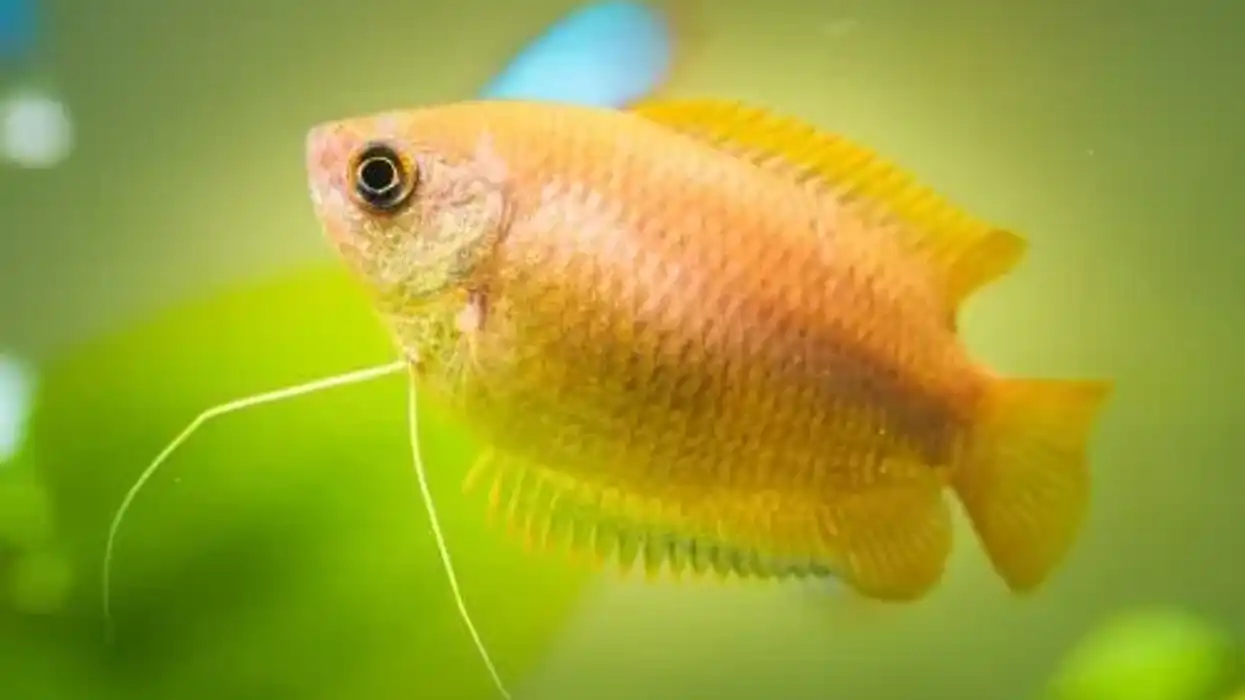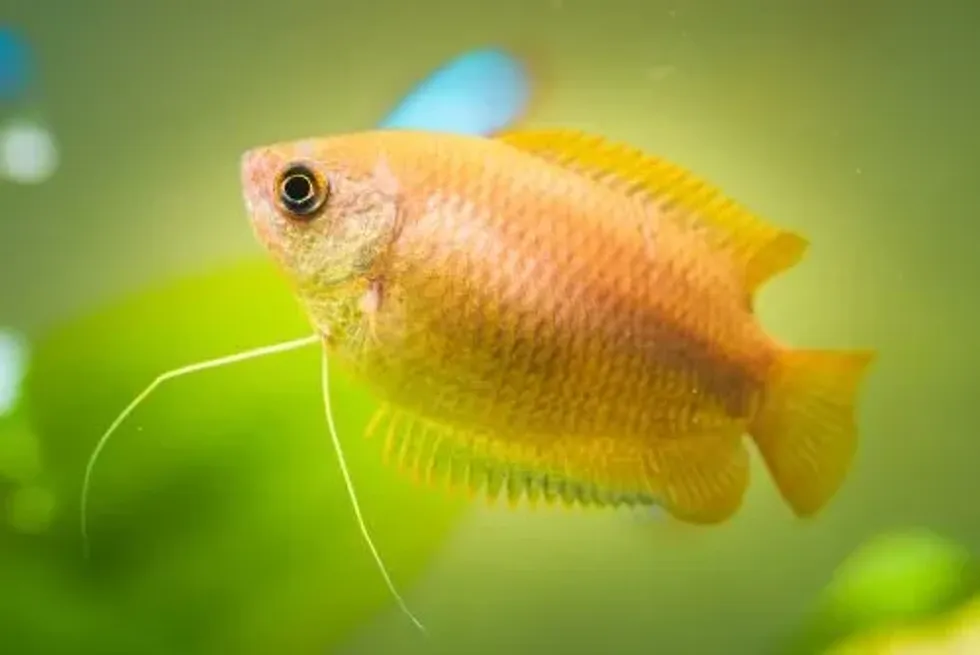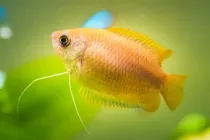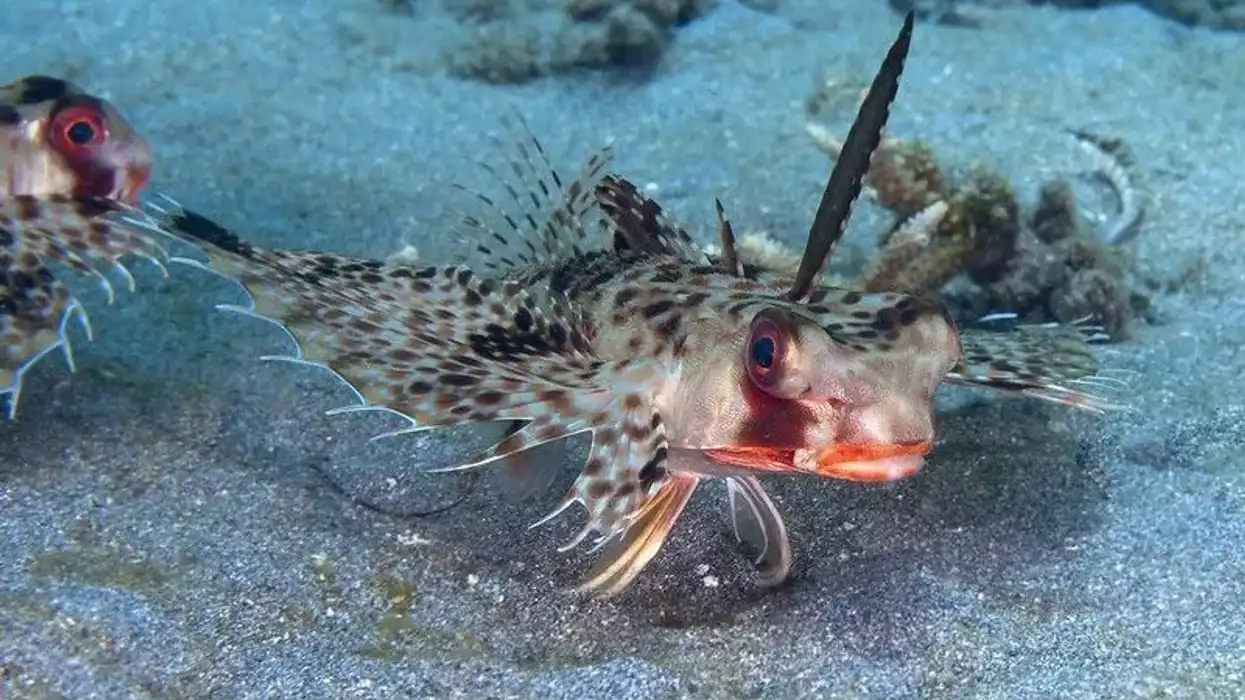Fun Honey Gourami Facts For Kids

Content
- What type of animal is a honey gourami?
- What class of animal does a honey gourami belong to?
- How many honey gouramis are there in the world?
- Where does a honey gourami live?
- What is a honey gourami's habitat?
- Who do honey gouramis live with?
- How long does a honey gourami live?
- How do they reproduce?
- What is their conservation status?
- What do honey gouramis look like?
- How cute are they?
- How do they communicate?
- How big is a honey gourami?
- How fast can a honey gourami swim?
- How much does a honey gourami weigh?
- What are their male and female names of the species?
- What would you call a baby honey gourami?
- What do they eat?
- Are they eaten by humans?
- Would they make a good pet?
- Did you know...
- How do honey gouramis establish dominance?
- Why do honey gourami's need dense vegetation?
If you want to read about an interesting South Asian fish that can double down as an excellent aquarium fish, then the honey gourami species is what you are looking for. This fish is part of the gourami family of fish and are native to the rivers and streams of the Indian subcontinent.
Due to their peaceful nature and slow pace, honey gouramis have gained significant popularity around the globe as pet fish.
However, they are sometimes confused with dwarf gouramis, especially honey dwarf gouramis.
As a result of their popularity as pets, different color variations of honey gouramis have been selectively bred to produce even more beautiful fish. Some of these are the dwarf fire gourami, the red-flame honey gourami, the red robin gourami, and the sunburst gourami.
If you are interested to learn more about this unique fish, keep on reading this article. If you want to learn more about different aquatic creatures, you should check out our articles on the skate fish and swai fish.
Honey Gourami Interesting Facts
What type of animal is a honey gourami?
The honey gourami (Trichogaster chuna) is a fish that is found in rivers and lakes. They are mainly found in South Asia.
This fish species is perfect as aquarium fish and often make good tank mates for other fish species in the aquarium. As a result of it being so popular amongst aquarium enthusiasts, many ornamental strains of this fish species have been produced by selective breeding.
What class of animal does a honey gourami belong to?
Honey gouramis belong to the class of Actinopterygii. The Actinopterygii class is a class of fish that houses different types of ray-finned fish species around the world. The scientific name of a honey gourami is Trichogaster chuna, but they also have other lesser-used scientific names. These are Trichopodus chuna, Colisa chuna, Trichopodus sota, Colisa sota, and Polyacanthus sota.
How many honey gouramis are there in the world?
As this species of fish is found in abundance in the river waters and lake waters in the Indian subcontinent such as India and Bangladesh, the total number of honey gouramis present cannot be deduced.
What also adds to their population is the fact that honey gouramis are kept in fish tanks and aquariums all around the world because they are easy to care for and are excellent tank mates.
Where does a honey gourami live?
The honey gourami species of fish are generally found in the rivers, streams, and lakes of India, Bangladesh, and sometimes Nepal. As already mentioned, honey gouramis are also found in water tanks and aquariums.
This fish species is especially popular in the freshwater aquarium fish community in the Indian subcontinent and they are also found in flooded fields and low water ditches.
What is a honey gourami's habitat?
The natural habitat of a honey gourami is river water, along with lakes and ponds, and ditches. However, in marine life, honey gouramis do not tend to be a species of aggressive fish.
On the contrary, this fish species is supposed to be quite shy and prefers to live in areas with thick vegetation. This is so that the green cover can double down as hiding places for this fish species whenever they feel uncomfortable or unsafe in their surroundings.
However, living near the green cover means that honey gouramis have to survive in poorly mineralized and oxygenated waters. They solve this problem by having a labyrinth organ which helps them to breathe within water parameters such as poorly oxygenated river water.
A honey gourami fish is also known to be a benthopelagic fish.
This means that they usually swim towards the water surface from the layer of river sediments. However, their behavior shows that honey gouramis are usually found in the middle and top layers.
This behavior is true in the case of an aquarium or water tank too. Sometimes, they can also be found sleeping in the bottom of the tank.
When they are kept in an aquarium or a water tank, the honey gourami tank size and the tank water conditions play an important role in determining the behavior of the fish in the aquarium habitat. They are perfectly suited for the slow-moving water of an aquarium.
Who do honey gouramis live with?
A honey gourami or a red flame gourami is not a social fish. They are usually very shy in nature.
However, they do enjoy the companionship of their own kind and can live together with four to six individuals. Honey gouramis are also known to generally swim in pairs. Even in an aquarium or water tank, a honey gourami pair is usually observed.
How long does a honey gourami live?
The lifespan of a honey gourami is usually between four to eight years. They may live for even longer when given the proper care in a water tank.
Honey gourami care includes factors such as appropriate water tank setup and water temperature amongst other water parameters. Yet, there are certain diseases like the velvet disease, bloating, constipation, and fin rot that severely hampers the lifecycle of this fish species.
How do they reproduce?
The honey gourami breeding process is very interesting. They become sexually mature at around the age of five months.
Male honey gouramis are responsible for raising the fry. Like most fish species in their family, honey gouramis are known to build bubble nests.
A bubble nest is basically a small nest made with oral secretion, aquatic plants, and the saliva of fish. Bubble nest-building fish are called aphrophils. Bubble nests are also known as foam nests.
Once these nests have been built, a male fish immediately starts to court a female honey gourami by displaying its dark blue coloration near its abdomens. A male fish is also known to chase a honey gourami female around the water or the tank as this is part of the mating ritual.
The mating process happens quite rapidly with the male and the female mating multiple times. There are as many as 20 eggs released per spawning and the male will fertilize those eggs immediately.
The spawning process will continue amongst the pair until around 300 eggs have been released. After the mating is over, males will carry the eggs into the bubble nest where they will try to keep the eggs in place by spitting water droplets above the nest.
The eggs hatch after 24 to 36 hours. During this time, males guard the nest while females are chased away.
In a captive environment, it can be recommended that male and female fish are kept together in a separate breeding tank. The water temperature of this honey gourami tank during mating should be somewhere around 80 F (27 C).
Breeding honey gouramis in a tank setting is quite easy actually. You can also feed the newly hatched fly some baby brine shrimp.
What is their conservation status?
Due to their popularity everywhere as aquarium fish and as great tank mates, the population of honey gourami is not under any severe threat of decreasing. They are also quite numerous in the wild.
This fact is reflected in the classification of Least Concern given to this species in their Red List as per the latest reports by the International Union For Conservation Of Nature or the IUCN.
Honey Gourami Fun Facts
What do honey gouramis look like?
Honey gouramis are quite similar in appearance to other gouramis such as dwarf gouramis. Sometimes, honey gouramis are confused with dwarf gouramis.
Also known as the sunset honey gourami, this fish species displays a gold to a slightly orangish shade of skin color which resembles the color of honey. This is how the honey gouramis came to be known as 'honey' gouramis.
The coloring is an important factor in the honey gourami male vs. female differences. While females show the basic coloring of light orangish-yellow with a mid-body light brown band, males display more coloration, especially during mating.
A male fish develops reddish-orange color in its anal fins and caudal peduncle, with a dark blueish abdomen and belly color. Sometimes, males are known as red honey gouramis.
This fish has the important adaptation of the labyrinth organ that helps them to breathe and survive in waters that have less oxygen content in them. Much like dwarf gouramis, honey gouramis have a somewhat compressed body.
However, they are much narrower as their dorsal and anal fins are not as large. On the other hand, their ventral fins have a threadlike quality to them and are supposed to be touch-sensitive.
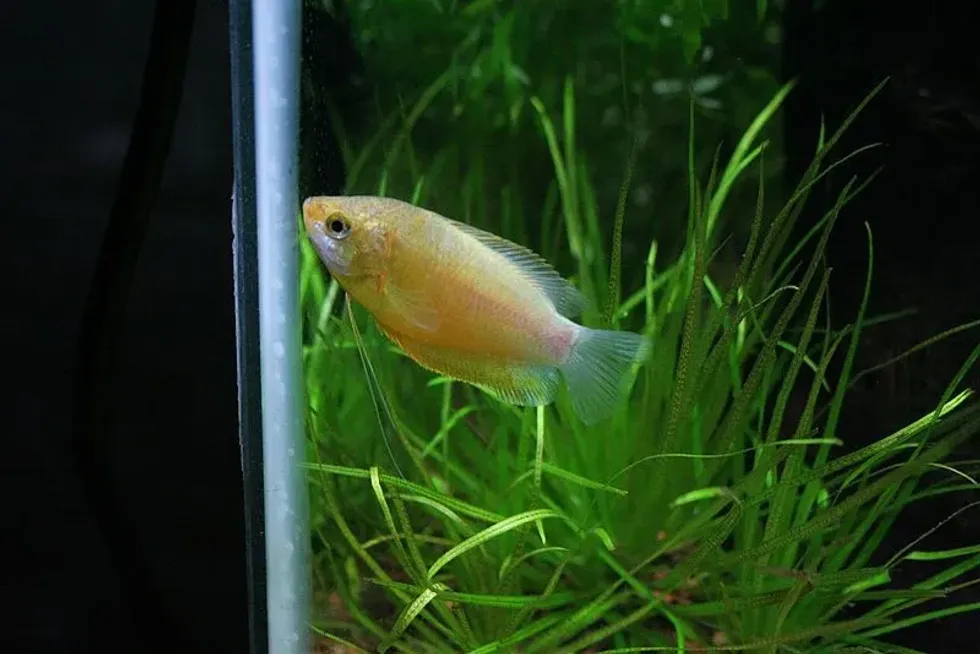
How cute are they?
Honey gouramis with their beautiful color schemes on their bodies are great fish to look at and you can always add them to your aquarium as tank mates for your other fish.
Even if they have a penchant for being aggressive fish sometimes, honey gouramis are generally shy and peace-loving fish. They have the unique ability to start displaying more color on their body when they feel safe.
What also adds to their cuteness quotient is the fact that honey sunset gouramis love to hide amongst the dense vegetation both in the wild and in tanks.
How do they communicate?
Honey gouramis are known to communicate during breeding via chasing, physical action, and through the display of colors. However, not much is known how gouramis communicate. Since we know that other fish communicate with each other through sound, electrical impulses, and smell, we can assume that honey gouramis also communicate via these means.
How big is a honey gourami?
The honey gourami size is small compared to other fish. Their total length is usually between 1.5-2 in (3.9-5.1 cm).
The largest a honey gourami can grow is thought to be around 3 in (7.7 cm). Interestingly, honey gouramis are known to display sexual dimorphism in themselves.
Males average around 1.5 in (3.9 cm) while females are known to be slightly bigger with a average total length of 2 in (5.1 cm). Also, the majority of the larger fish are found in rivers. When kept in a tank or aquarium, the size of this fish is relatively smaller.
In comparison, members of the trout family are on an average five to seven times bigger than honey gouramis. Also, average dwarf gouramis are just slightly larger with a 3.5 in (8.9 cm) length.
How fast can a honey gourami swim?
Honey gouramis are generally not thought to be fast swimmers in nature. Due to a lack of sufficient data and research, the exact swimming speed of this fish type is not conclusive.
Yet, other observations have shown us that honey gouramis do not do too well when placed in fast-moving waters or currents.
Their natural shape, size and, behavior have led us to conclude that this fish type is best suited to the habitat of slow-moving rivers and in a tank. This is an important aspect of honey gourami care.
How much does a honey gourami weigh?
Being a small fish, red honey gouramis do not weigh a lot. This timid and shy fish is known to have a weight of around 0.2 lb (91 g) with males being slightly lighter than the females. This is because this fish shows sexual dimorphism within their genders.
What are their male and female names of the species?
Scientifically, males and females had different names initially. Males were called Trichopodus chuna and females were called Trichopodus sota. However, now both males and females are classed under one name, Trichogaster chuna.
What would you call a baby honey gourami?
Like all fish, a baby honey gourami is known as a 'fry'.
What do they eat?
Honey gouramis are omnivores in nature. They are known to attack their prey by spraying water bubbles towards them.
The normal diet of honey gouramis includes small marine invertebrates, insects, planktons, vegetation, and plants. In a tank, honey gourami care includes their diet to manage their bloating problem. Nutritional pellets, tubifex worms and bloodworms make is good tank food for them.
Are they eaten by humans?
While giant gouramis are generally eaten in Southeast Asia, honey gouramis are thought to be decorative aquarium fish. This means they are almost never consumed by human beings.
Would they make a good pet?
Honey gouramis are known to make excellent pets in an aquarium or tank. However, it is important to follow certain measures while housing them in a tank.
Firstly, the tank size should be ideally around the 10 gal (45 l) for a pair. The honey gourami temperature of this water tank should not exceed more than 82 F (28 C).
Care should also be taken while choosing honey gourami tank mates. Ideal honey gourami tank mates include cory catfish, sparkling gouramis, guppies, small barbs, mollies, and zebra danios.
However, fish like bettas and tiger barbs are known to nip at their fins and honey gouramis are a perfect target due to the slow-moving nature. Also, to avoid infections in honey gouramis, the tank should have frequent water changes.
Clean water will ensure that honey gouramis are healthy. It is recommended that you shouldn't keep more than four to six honey gouramis together in a tank.
Did you know...
There are many different honey gouramis sold in pet stores that are actually not honey gouramis. These imposter dwarf honey gourami fish are actually color variations of thick-lipped gourami or the Trichogaster labiosa.
Honey gouramis have the ability to detect food from a distance. They have specially adapted fins that have taste buds on them. This is an adaptation caused by living in murky river waters.
How do honey gouramis establish dominance?
Although these fish are generally shy, they do tend to get aggressive in order to assert their dominance but they are not territorial. They travel in small schools and they find a way to establish a hierarchical order within the group.
Dominant individuals in this school are known to chase away other fish during feeding time by being aggressive towards each other.
Why do honey gourami's need dense vegetation?
Honey gouramis are known to need dense vegetation both in the wild and in the tank where they are kept. This is because this fish species is usually very shy and will often hide amongst vegetation when they are bullied by other fish or when they are stressed.
Here at Kidadl, we have carefully created lots of interesting family-friendly animal facts for everyone to discover! Learn more about some other fish including blue tang, or blobfish.
You can even occupy yourself at home by drawing one on our Honey gourami coloring pages.
We Want Your Photos!
More for You
See All
Bachelor of Arts specializing in Journalism and Mass Communication, Postgraduate Diploma in Sports Management

Moumita DuttaBachelor of Arts specializing in Journalism and Mass Communication, Postgraduate Diploma in Sports Management
A content writer and editor with a passion for sports, Moumita has honed her skills in producing compelling match reports and stories about sporting heroes. She holds a degree in Journalism and Mass Communication from the Indian Institute of Social Welfare and Business Management, Calcutta University, alongside a postgraduate diploma in Sports Management.
Bachelor of Law

Abdulqudus MojeedBachelor of Law
A versatile professional with a passion for creative writing and technology. Abdulqudus is currently pursuing his Bachelor of Law from the University of Lagos and has experience as a tutor, intern assistant, and volunteer. He possesses strong organizational skills and is a detail-oriented person.
Disclaimer
1) Kidadl is independent and to make our service free to you the reader we are supported by advertising. We hope you love our recommendations for products and services! What we suggest is selected independently by the Kidadl team. If you purchase using the Buy Now button we may earn a small commission. This does not influence our choices. Prices are correct and items are available at the time the article was published but we cannot guarantee that on the time of reading. Please note that Kidadl is a participant in the Amazon Services LLC Associates Program, an affiliate advertising program designed to provide a means for sites to earn advertising fees by advertising and linking to Amazon. We also link to other websites, but are not responsible for their content.
2) At Kidadl, we strive to recommend the very best activities and events. We will always aim to give you accurate information at the date of publication - however, information does change, so it’s important you do your own research, double-check and make the decision that is right for your family. We recognise that not all activities and ideas are appropriate for all children and families or in all circumstances. Our recommended activities are based on age but these are a guide. We recommend that these ideas are used as inspiration, that ideas are undertaken with appropriate adult supervision, and that each adult uses their own discretion and knowledge of their children to consider the safety and suitability. Kidadl cannot accept liability for the execution of these ideas, and parental supervision is advised at all times, as safety is paramount. Anyone using the information provided by Kidadl does so at their own risk and we can not accept liability if things go wrong.
3) Because we are an educational resource, we have quotes and facts about a range of historical and modern figures. We do not endorse the actions of or rhetoric of all the people included in these collections, but we think they are important for growing minds to learn about under the guidance of parents or guardians.
